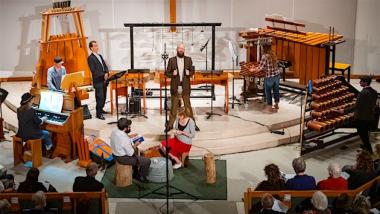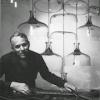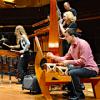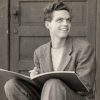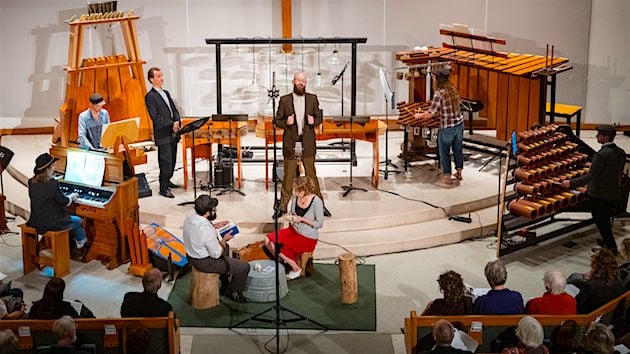
When we think of America’s great chroniclers of the open road, we think of the verses of Walt Whitman, the Dust Bowl ballads of Woody Guthrie, and the Bohemian rhapsodies of Jack Kerouac.
Very few people would include the iconoclast, itinerant, and irascible composer Harry Partch. But then, how many people have ever had the chance to hear a complete performance of his remarkable hobo-opera in five parts, The Wayward, subtitled: A collection of musical compositions based on the spoken and written words of hobos and other characters— the result of my wanderings in the Western part of the United States from 1934–1941?
In its final revised version (first performed in 1968), The Wayward unfolds as a cross-country odyssey inspired by the nine years during the Great Depression that Partch spent as a “broke-ass poor” hobo/composer. He rode the rails and thumbed rides across the country, often as not to get from one opportunity for musical employment to another, his self-created array of instruments packed up and shipped on ahead. They were hard times and it was a tough life. But despite that, it appealed to Partch for its camaraderie of the rails and the freedom of the open road.
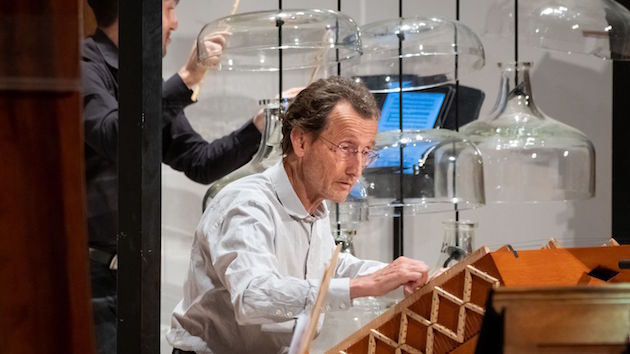
Available on recording but rarely performed live, The Wayward received its first complete performance by the members of the PARTCH Ensemble on Saturday, Nov. 9, presented by Jacaranda at the First Presbyterian Church of Santa Monica. It was a revelatory experience that offered a color-filled, dramatically executed exploration of Partch’s creation. It also served as a cogent reminder of current hard times and how an epidemic of homelessness is plaguing our cities.
According to PARTCH Ensemble founder (and principal instrument builder) John Schneider, for 18 of its 20 years in existence, the ensemble had looked forward to the moment when they possessed all the necessary instruments to perform The Wayward — instruments tuned in just intonation with an octave division of 43 tones. Partch once observed that it was his dedication to just intonation that transformed him from a composer of complex music into a reluctant carpenter.
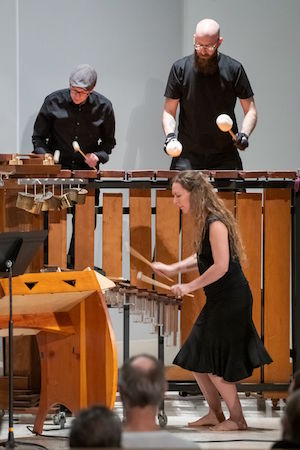
The performers were also determined to create a performance that was in keeping with Partch’s love of theater that could capture a Depression-era flavor. So, as the first “act” — Barstow – Eight Hitchhiker Inscriptions From a Highway Railing at Barstow, CA began, four members of the group found themselves huddled around a cook pot swapping tales of the road, offering expletive-ridden comments in a decidedly bitter manner.
As the scene evolves, the hobos’ banter is accentuated by Partch’s distinctive instruments: microtonal strums, plucks, and harmonic slurs from the surrogate kithara and large kithara II, bell-like tones from the cloud chamber with its chorale of suspended glass bowls, contrasting polyrhythms from diamond marimba and the enormous deep-voiced bass marimba, the clicky-clack of the multitubed bamboo boo II, and the melodious moans (to quote Leonard Cohen, “like a drunk in midnight choir”) of the modified organ Partch christened the chromelodeon.
The huddle of the jungle camp gives way to the hawking of newsies: San Francisco – A Setting of Cries of Two Newsboys on a Foggy Night in the Twenties, with members of ensemble in the aisles brandishing the latest yellow journalism headlines of the Chronicle. Next came The Letter – A Depression Message From a Hobo Friend, with Schneider performing the role of a slouchy, hatted narrator.
It all builds toward what is by far the work’s most descriptive and lengthy movement — U.S. Highball – A Musical Account of a Transcontinental Trip, from San Francisco to Chicago. It incorporates the entire array of instruments as well as narrative and song to form a truly great piece of American musical landscape painting.
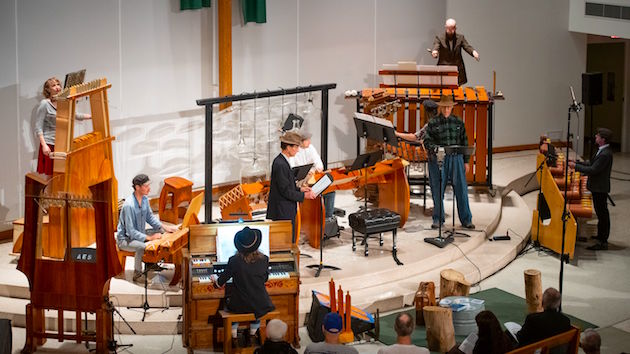
As the hero makes his way across the country, jolting along in an empty boxcar, puffing “over the hump to Cheyenne,” his thumb out for anyone “goin’ east,” Partch layers tones atop tones and creates polyrhythms that clatter like the rails. There’s even a sarcastic “praise the Lord” hymn offered up at a Salvation Army soup kitchen. It’s Whitman’s lure of the open road fragmented and filtered through the caustic lens of the Depression. It’s Kerouac before Kerouac. It’s Steve Reich before Different Trains.
The entire journey ends with a sultry, jazz-influenced coda with trumpet and saxophones that Partch added in 1955. It is appropriately titled for another great wanderer, Ulysses at the Edge of the World (A Minor Adventure in Rhythm).
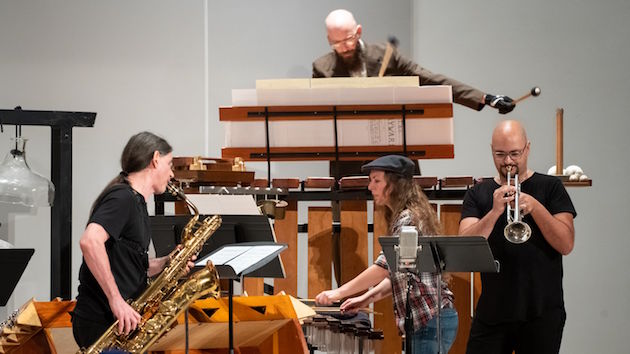
To complete the program the ensemble performed two shorter Partch creations — the somber tones of Dark Brother from 1942–43, with T.J. Troy intoning the vocal part, and Castor & Pollux: A Dance for the Twin Rhythms of Gemini from 1952, which moves dance-like as the music and the musicians shift from one grouping of instruments to another.
It could be said that in keeping with his less-than-cuddly personality, Harry Partch painted himself into a musical/historical corner, since his desire to expand beyond Western tonal horizons led him to compose pieces that could only be played on instruments of his own creation.
Thankfully, we have the members of the PARTCH Ensemble: John Schneider, Paul Berkolds, Vicki Ray, Matt Cook, Erin Barnes, Alex Wand, Nick Terry, Derek Stein, Dan Rosenboom, Ulrich Krieger, T.J. Troy, and Alison Bjorkedal, who are dedicated to keeping Harry Partch’s legacy — and his spectacular instrument designs — alive.

